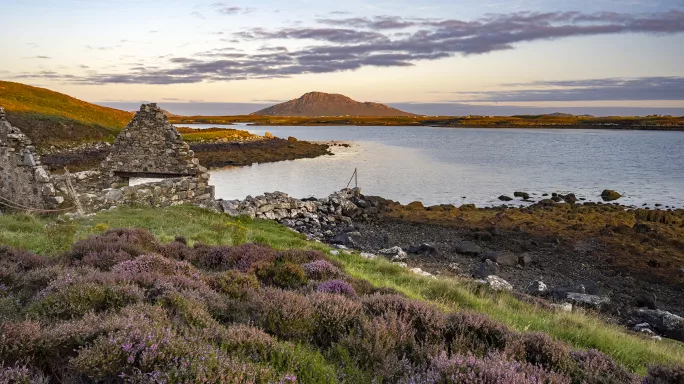Gaelic education in Scotland: how much progress has been made?

In August, Renfrewshire Council became the latest Scottish local authority to introduce Gaelic-medium education for primary pupils. Now, half of Scottish councils (16 out of 32 authorities) offer primary Gaelic-medium education almost four decades on from the first primary units being established in 1985 in Glasgow and Inverness.
They began with a couple of dozen pupils in total. Now over 3,500 primary pupils are taught through the medium of Gaelic in Scotland, while many people more generally are being drawn to Gaelic - by February this year over a million people had accessed the Duolingo language learning app’s Gaelic course.
Still, experts say that the language’s future remains precarious. Wilson McLeod, professor of Gaelic at the University of Edinburgh, says it is becoming a “network language” - spoken between family members and between friends and acquaintances with the linguistic skills - but not tied to a particular geographic area.
“The idea of the tight-knit rural community where everyone speaks the same language seems less likely at this stage,” he says, while adding that “nothing is impossible with the right support and the right commitment”.
However, discussion about how far interventions should go - and the role that education should play in the promotion and preservation of Gaelic - can become clouded by politics, with the promotion of Gaelic decried by critics as a nationalist project.
But McLeod disagrees with the portrayal of the SNP “forcing Gaelic down people’s throats”. Indeed, he is highly critical of the Scottish government, accusing it of being “tentative” and “half-hearted” in its approach to the language.
The Labour-Lib Dem administration from 1999 to 2007 did more for Gaelic than has been done since the SNP came to power, he says. He describes the amount being invested by the Scottish government in Gaelic as “pitiful” and says there has been “very little serious policy in relation to Gaelic” and some “serious opportunities” missed.
In fact, McLeod argues, parents rather than politics have been the driving force behind the growth of Gaelic-medium education (GME).
Certainly, it was parents who got the first GME classes up and running in 1985 and it was parents who made the case for introducing GME in Renfrewshire in August - albeit new laws introduced by the Scottish government set out the process for such a request.
But with a Scottish Languages Bill in the offing and the government consulting until mid-November on matters Gaelic and Scots, might parents hope that in the future there will be less onus on them, that a more strategic approach be taken to Gaelic-medium education?
- Related: New push to help Gaelic and Scots languages ‘thrive and grow’
- News: Government to miss target for setting up Gaelic schools
- Interview: Why every school leaver should have experience of Gaelic
- Research: How a Gaelic education brings bilingual benefits
Catriona McCabe was one of the parents who pushed to get Gaelic-medium education up and running in Renfrewshire this year and she certainly hopes so.
McCabe was raised on Lewis in the Western Isles, one of the only parts of Scotland where Gaelic remains widely spoken in the community. She wanted her son, Theo, to learn the language because of the benefits bilingualism brings - but also because she wanted to maintain that link with home.
“I wanted Theo to have that connection with the island. He loves going up there and it’s part of his heritage.”

But pursuing GME is “definitely not the easy road”, she says, adding: “You are always having to push for something.” Too much onus is placed on parents to know “the ins and the outs of the law”. She believes councils need to do more to promote that it is possible to request GME.
McCabe contrasts her experience of trying to secure GME on the mainland with that of her sisters, three of whom still live on Lewis.
In 2020, Gaelic became the default language of instruction for all primary school pupils in the Western Isles. This year in the authority, more P1s entered GME than English-medium education and, in total, 45 per cent of primary pupils in the Western Isles are being educated through Gaelic.
McCabe’s nieces and nephews, therefore, automatically had access to GME at their local primary. By contrast, her son had to attend a primary in a neighbouring authority - after three placing requests had been refused - because his home authority, Renfrewshire Council, did not have any GME primary provision at that time.
This year, however, a unit opened up at West Primary in Paisley after a group of parents - including McCabe - put a request for GME into the council. In Scotland, parents have the right to request Gaelic-medium primary education for their child in an area that does not have Gaelic provision; the recommendation is that there should be five children in the same year group seeking GME to trigger a full assessment of demand. And councils can still choose to take action if numbers are lower or if - as in Renfrewshire - children are spread across a number of year groups.
So in August, Theo started attending West Primary’s newly established Gaelic class with six other GME pupils, who make up a composite P1-3 class.
Yet, many parents pursuing GME in Scotland continue to be pioneers - and the next challenge looming on the horizon for McCabe and her family will be securing secondary provision.
Even in an area such as the Western Isles, where the council has made clear its commitment to the language, actually delivering is a constant struggle. Recruiting secondary Gaelic teachers, in particular, is a huge challenge.
The e-Sgoil - which specialises in live online lessons from its Western Isles base - has become well known across Scotland because of the coronavirus pandemic and the role it played nationally in sharing its expertise and organising virtual classes.
However, when the e-Sgoil was launched in 2016, it was in large part because Western Isles Council was struggling to deliver on its goal that all pupils should have access to six secondary subjects through the medium of Gaelic.
At the Nicolson Institute in Stornoway - the biggest secondary in the Western Isles, with over 1,000 pupils - around a quarter of the roll are GME students. In the first two years of secondary school, roughly half of the curriculum can be delivered through Gaelic, but this drops off sharply from S3, largely because of a lack of staff.
Jim Whannel - director of Gaelic education at the public body responsible for promoting the language, Bòrd na Gàidhlig - points out that recruiting teachers to remote and rural areas is always challenging, but that challenge is more acute when you start fishing in the much-reduced pool of teachers who are fluent in Gaelic.
In primary schools, however, it tends to be more straightforward to get delivery up and running, as only one teacher is required. In secondary, with its subject specialisms, things become more complicated.

Gaelic as an additional language
Whannel argues that Scotland could get a lot better at delivering Gaelic as an additional language, in the same ways as the likes of French and Spanish are offered. Increasing the number of pupils learning Gaelic as a foreign language in secondary would be another way of boosting the Gaelic-speaking workforce, he says.
In 2022, however, there were just 135 entries for the Scottish Qualifications Authority (SQA) Gaelic learners National 5 qualification - for French, there were over 6,500.
For now, says Whannel, there is really only one route for producing the Gaelic teachers of the future, and that is Gaelic-medium education.
Secondary head Peter Bain agrees that more exposure to Gaelic in school is the key to teacher supply problems. At his school, Oban High, Gaelic is compulsory as a language in S1, and then S2s choose between pursuing Gaelic or French. Traditionally, French has been more popular but this year, for the first time, similar numbers are taking the two languages.
However, the school is struggling to give its GME students instruction in the language beyond Gaelic classes. When the school advertises for new staff it always seeks to recruit teachers with Gaelic, but is seldom successful.
“What we need is more Laurens,” says Bain, referring to the school’s depute head Lauren Morrison, who is responsible for transitions and Gaelic - as well as being a social subjects teacher - and is a fluent Gaelic speaker.
Bain would like to see financial incentives to encourage Gaelic speakers who enter teaching to make use of their skills. Just as there is a financial incentive of up to £8,000 for new teachers to spend their probation in any part of the country - through the “preference waiver” scheme - there should be an equivalent sum to encourage teachers with Gaelic to hone their skills so that they can deliver lessons in the language, he says.
Bain also supports the idea of establishing more dedicated Gaelic-medium secondaries such as the Glasgow Gaelic School, which has around 450 pupils.
For now, though, GME students often stop short of pursuing national qualifications in Gaelic rather than English in the senior phase of secondary. The SQA offers national qualifications in the Gaelic language and exams in Gaelic in five subjects: geography, history, mathematics, applications of mathematics and modern studies. But uptake is exceptionally low - just 205 pupils sat the N5 Gaelic speakers qualification (Gaidhlig) last year and the most popular Gaelic-medium qualification was N5 maths, with a total of 70 entries; Higher history, geography and modern studies Gaelic exams have not had any entries for years.
Robert Quinn, head of English, languages and business at the SQA, says: “We need to make sure that people don’t see Gaelic medium as something you just do in the broad general education [before the senior phase of secondary school].”
That many do not “might be about resources and teachers - but it could be about hearts and minds as well”.
He stresses that, while numbers are small, those that take exams in Gaelic are “very committed” and tend to do well.
Quinn says the SQA - which is set to be replaced by a new body in 2024 - stands ready to increase its offer in line with demand; he hints that biology exams could be the next to be offered in the language after the first GME students attained an N4 biology qualification last year.
An independent review of assessment and qualifications is underway, in the wake of huge uncertainty and disruption during the Covid pandemic.
GME must be considered as part of that review, says Magaidh Wentworth, the manager of Comann nam Pàrant, the national parents’ advice and support organisation on GME.
Pupils who undertake GME but who do not go on to sit national qualifications “need some accreditation for that”, she says. And those who do go on to take exams should be allowed more time (writing in Gaelic takes longer, she says) and should be given access to a dictionary, because in the vast majority of cases Gaelic will be their second language.
And that crucial point - that most pupils who pursue GME do not have Gaelic as their first language - also needs more consideration when it comes to class sizes, she believes.

Are class sizes limiting Gaelic education?
McLeod estimates that in urban areas, at least 90 per cent of pupils in GME do not come from Gaelic-speaking homes and that in many cases the teacher is “the sole input of Gaelic”.
Class sizes used to be small in the 1990s, but as GME has increased in popularity that has changed, especially in more urban areas, yet class size maximum limits are the same irrespective of whether English or Gaelic is the language of instruction.
Wentworth says: “We are trying to deliver GME on an equal basis with English medium but it’s different and we need to recognise that.
“We are educating children who mainly do not have Gaelic as their first language, so we need more support for teachers with these bigger classes. In most cases, they are delivering education and a second language to the children and they need more support to do that.”
However, as McLeod acknowledges, smaller class sizes would require an increase in teacher numbers and already teachers are hard to find - although language assistants could support teachers, suggests Wentworth.
But that would require more investment - something McLeod says the Scottish government has not been quick to provide up to now.
“The level of financial support from the government in Scotland is really pitiful. I mean people from other countries - the Basque Country for instance - hear what is being done for Gaelic and they are almost embarrassed for you. They feel the scale of it is just so, so minimal.”
The Scottish government says that Gaelic is a significant part of Scotland’s culture and it is committed to seeing Gaelic “thrive and grow”. It says the budget for Gaelic has almost doubled since 2006-07, going from £15.3 million then to £29.8 million today, and it recognises the value of the language to Scotland’s economy.
It adds that the recently launched consultations are “aimed at ensuring a robust future for the language” and it is committed “to supporting access Gaelic-medium education for those that wish to have it” and is working with partners to create new pathways into teaching.
Still, McLeod says that the spending of the Welsh government on the Welsh language is “an order of magnitude higher” even though it is a smaller country. Welsh-medium education is “just massive by comparison”.
There are 439 Welsh-medium schools and 109,331 pupils (23 per cent) are educated in Welsh-medium schools. In Scotland, the government set itself the target of setting up 10 standalone Gaelic schools in total by next year and is set to miss it; there are currently seven. Around 1 per cent of primary pupils in Scotland are in GME and around 0.5 per cent of secondary pupils.
In Wales, learning Welsh is also mandatory until the age of 16 and the government has set the ambitious target of creating a million Welsh speakers by 2050.
Welsh, however, is much more widely spoken: the 2011 census showed 19 per cent of the population was able to speak the language, compared to 1.7 per cent of the Scottish population that reported having “some Gaelic language skills” - and that did not always extend to being able to speak it.
There are some green shoots, however. Thanks in large part to the drive and determination of parents, GME is growing - albeit slowly.
Next year, a new Gaelic primary will open in Glasgow and in 2023 East Renfrewshire Council will also start delivering primary GME for the first time. And the experience in the Western Isles shows if an authority takes a bold step like making Gaelic the default language of instruction, it will have an impact on numbers.
There are also more Gaelic speakers out there generally these days, says McLeod. He talks about “the Duolingo factor” and the new Scottish Social Attitudes Survey published in June, which showed the number of people who say they can speak “at least the odd word of Gaelic” had doubled in the last 10 years, going from 15 per cent to 30 per cent.
Undoubtedly, however, one of the most notable things about Gaelic-medium education is how erratic and slow progress has been - as well as how little has changed for parents.
In the coming weeks and months, as the Scottish Languages Bill is revealed, it will become apparent if the Scottish government has the will to change that.
Register with Tes and you can read two free articles every month plus you'll have access to our range of award-winning newsletters.
Keep reading with our special offer!
You’ve reached your limit of free articles this month.
- Unlimited access to all Tes magazine content
- Save your favourite articles and gift them to your colleagues
- Exclusive subscriber-only stories
- Over 200,000 archived articles
- Unlimited access to all Tes magazine content
- Save your favourite articles and gift them to your colleagues
- Exclusive subscriber-only stories
- Over 200,000 archived articles
topics in this article



